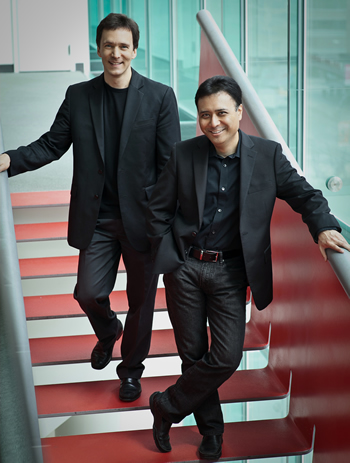This concert in Christ United Methodist Church was preceded by a Gala Fund Raising Dinner to help establish The Ingram Memorial Fund in memory of Henry Ingram who, along with his wife Lucy, founded the Music in a Great Space series to take advantage of the church’s magnificent organ, to invite the finest soloists and chamber musicians, and to facilitate educational outreach in the city’s public schools. This penultimate 23rd Season concert welcomed the return of the Manasse-Nakamatsu Duo, a favorite among regional audiences. Clarinetist Jon Manasse is a member of the Juilliard School faculty besides having an active solo and ensemble career. Jon Nakamatsu was the Tenth Gold Medal winner of the Van Cliburn International Piano Competition and is much in demand as a soloist as well as a chamber musician. Besides appearances as a Duo in the area, both have appeared on many series as soloists. Each player was given ample solo exposure over the course of their eclectic menu.
The Drei Fantasiestücke (Three Fantasy Pieces), Op. 73, for clarinet and piano, by Robert Schumann (1810-58), were written over two days in February 1849. While originally composed for clarinet, they have been arranged for viola or cello. The title reflects the composer’s belief that creative expression ought to be the product of the unrestricted imagination of the artist. The first piece, in A minor, begins in a hushed melancholy but slowly builds to a hopeful A Major ending. The playful middle piece is in A and is chromatic. The third piece, also in A, bursts with energy and demands the most from both players.
The first thing to strike the listener was Manasse’s extraordinary breath control as he spun out seamless melodies from his clarinet or ran the gamut of dynamics from a floated pp to an explosive ff. Nakamatsu’s Steinway had its lid fully raised but he balanced his dynamics perfectly with Manasse’s. Schumann’s sound texture is very different from such composers as Chopin or Brahms, and Nakamatsu conjured up this quality ideally. Both could weave seamless melodic lines and shaded dynamics. The fruity chromatic modulations of the middle piece were recreated beautifully by Manasse.
Claude Debussy (1862-1918) composed his Première Rhapsodie (First Rhapsody) for Clarinet and Piano between December 1909 and January 1910 as an examination piece for the Paris Conservatory where it was premiered (26 times) on July 14, 1910. Manasse commented Debussy wrote the piece to “test” clarinetists, and that the composer, when asked how he liked it, replied he had just heard it played 26 times…badly!
The Duo played the work marvelously. Nakamatsu’s impressionistic opening made one wish to hear him play a solo set of Debussy. Manasse’s control of breath, color, and dynamics was riveting. The piece abounds in sudden twists and turns, trills, jazzy sections, all of which the Duo controlled relentlessly like bronco riders.
Frédéric Chopin (1810-49) composed his famous Andante spinato et grande polonaise brillante in E-flat in stages between 1830-31 and 1834. The showy Grande Polonaise was written first, for piano and orchestra, in 1830-31. The gentle Andante spianato (in G) for piano solo was composed in 1843. Chopin joined it to a solo piano version of the Grande Polonaise with a brief fanfare-like sequence. This co-joined solo work is a major arrow in every keyboardist’s quiver.
Nakamatsu conjured the hushed, rippling notes of the opening magically before pulling out all the stops for the almost Liszt-like bravura of the polonaise. His performance was an excellent balance between artistic taste and powerhouse virtuosity.
Sonata in B-flat, for clarinet and piano (1962), is one of the last completed works of Francis Poulenc (1899-1963). It was one of the many significant commissions of clarinetist Benny Goodman who premiered the piece in Carnegie Hall in April 10, 1963, with Leonard Bernstein substituting for the deceased composer/pianist. It is in three movements: Allegro tristamente, Romanza (Très calme), and Allegro con fuoco (Très animé). The “fast-sad” first movement is itself divided into three parts “fast-slow-fast.” It always is in motion but the clarinet creates musical shapes but no tunes as its moves over a shifting harmonic background. The clarinet weaves a somber melody, occasionally elaborated upon, in the middle movement while the finale is a mad dash with a typical mix of comedy with the serious.
The Duo captured Poulenc’s unique blend of sassy playfulness juxtaposed against a mood of solemnity. Both brought out the tonal color of the score beautifully. Manasse’s almost soundless playing of his instrument’s keys and lack of extraneous air escaping was breathtaking. Poulenc’s whimsical style was perfectly captured.
The Manasse-Nakamatsu Duo members are co-directors of the Cape Cod Chamber Music Festival, where they have maintained a growing roster of new commissions.
“Lecuonerias” is the third movement from The Cape Cod Files (2009) by Paquito D’Rivera. According to the Boosey & Hawkes website the solo clarinet improvises around some of the melodies composed by Ernesto Lecuona, the foremost Cuban composer and pianist extraordinaire. Manasse’s performance was terrific!
Next, two of the Four Rags for Two Jons by John Novcek (b.1964). No. 1 “Schenectady” and No 4 “Full Stride Ahead.” were sandwiched around the “unofficial” world premiere of two short pieces by Gordon Goodwin (b.1964). “Schenectady” has a jaunty rhythm, starts as a traditional Scott Joplin-like rag before speeding up and getting very complex in its rhythm. “Full Stride Ahead” has sudden pauses and tempos changes. The two Goodwin pieces, especially the first, provided strong contrast, an almost pastoral peacefulness.
Manasse and Nakamatsu played with amazing virtuosity and with a considerable sense of fun and wit. Their thoroughly engaging playing brought the audience to its feet for prolonged enthusiastic applause which was rewarded with a white hot rendition of “I Got Rhythm” by George Gershwin.











